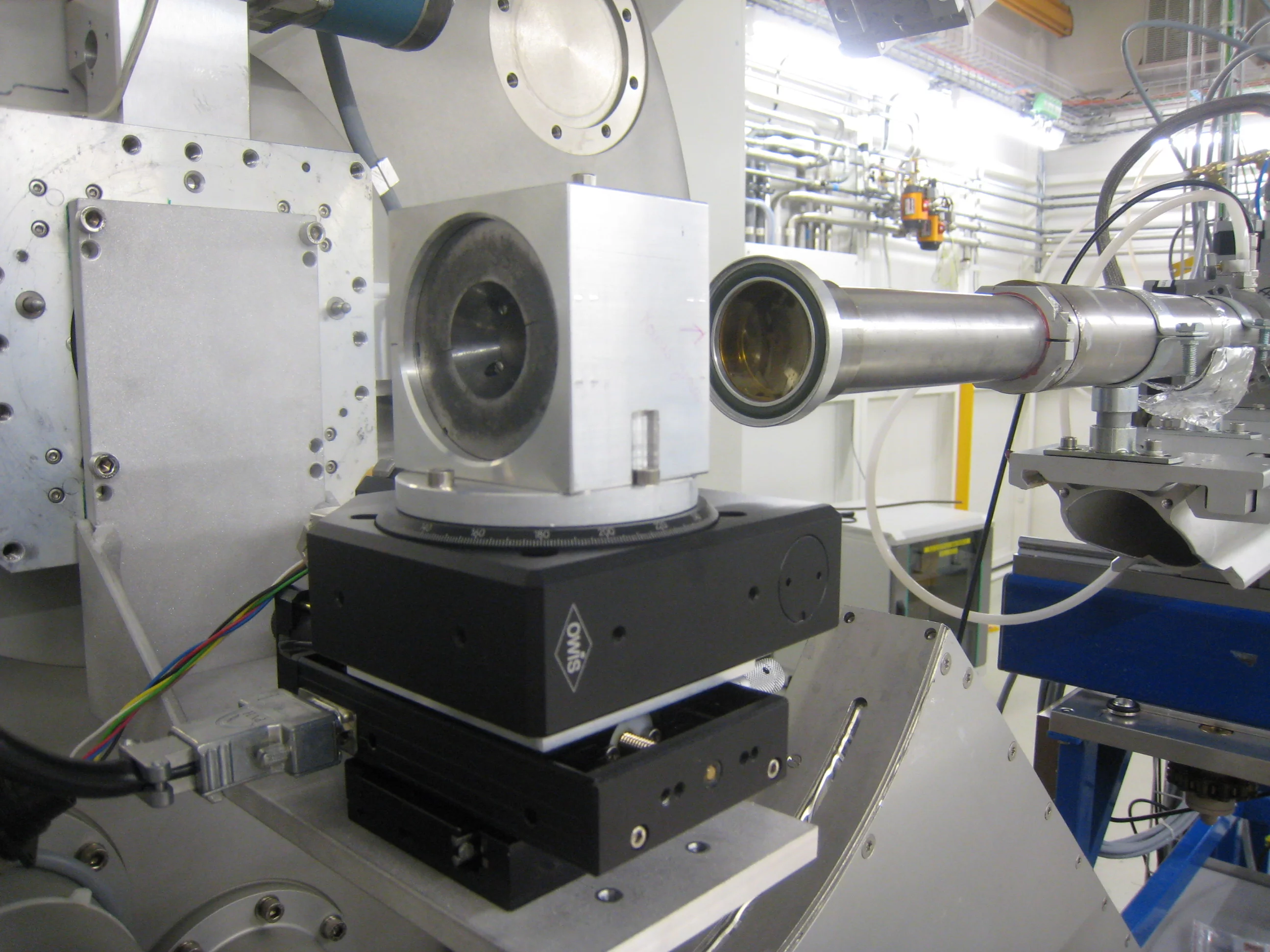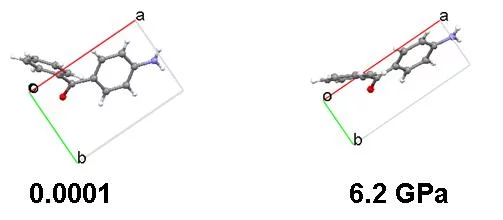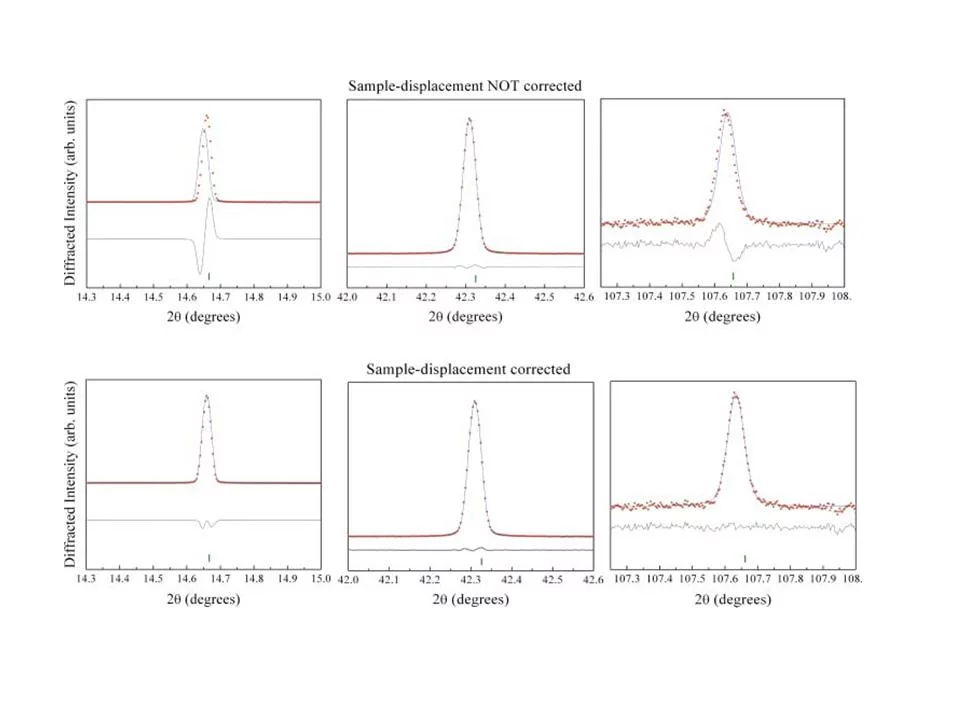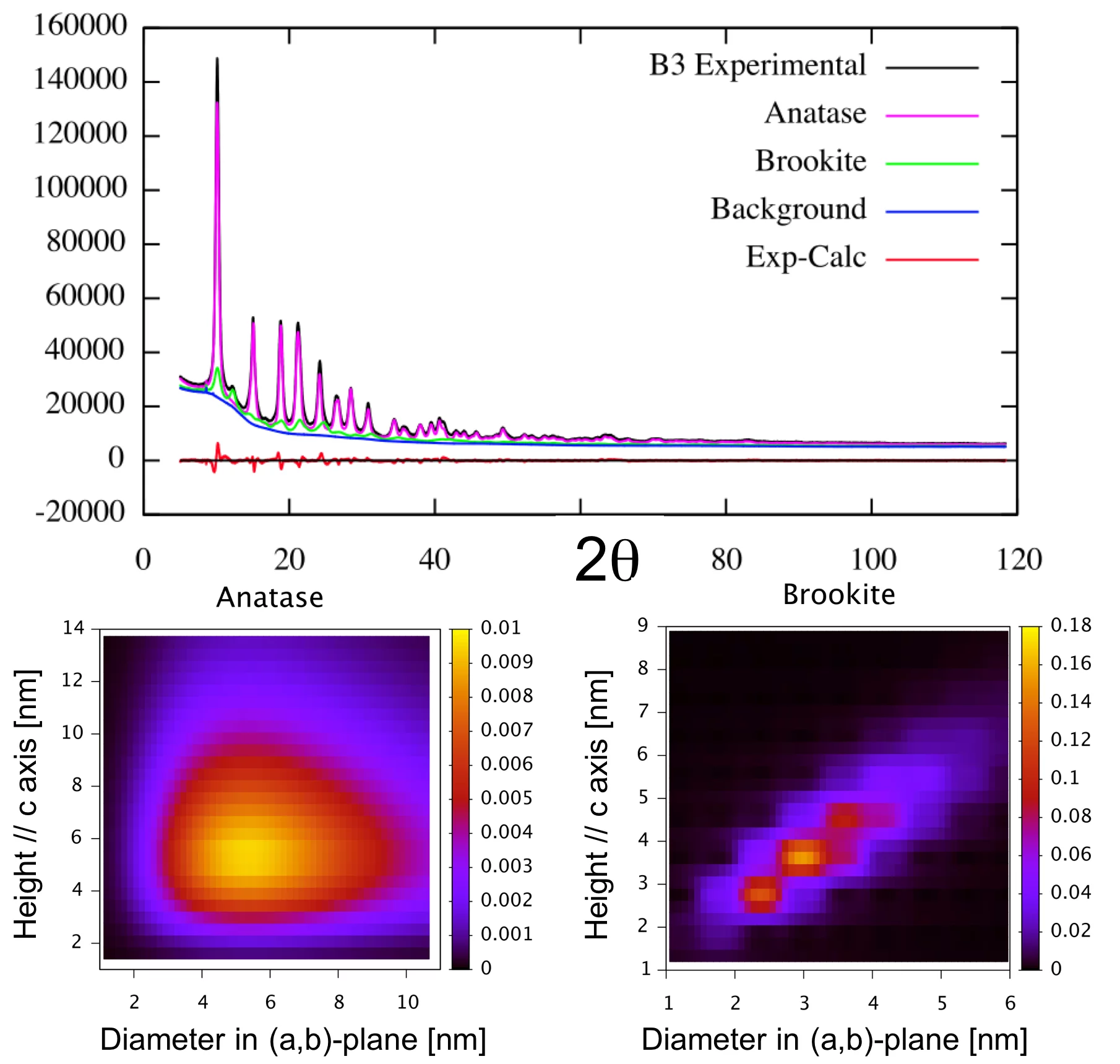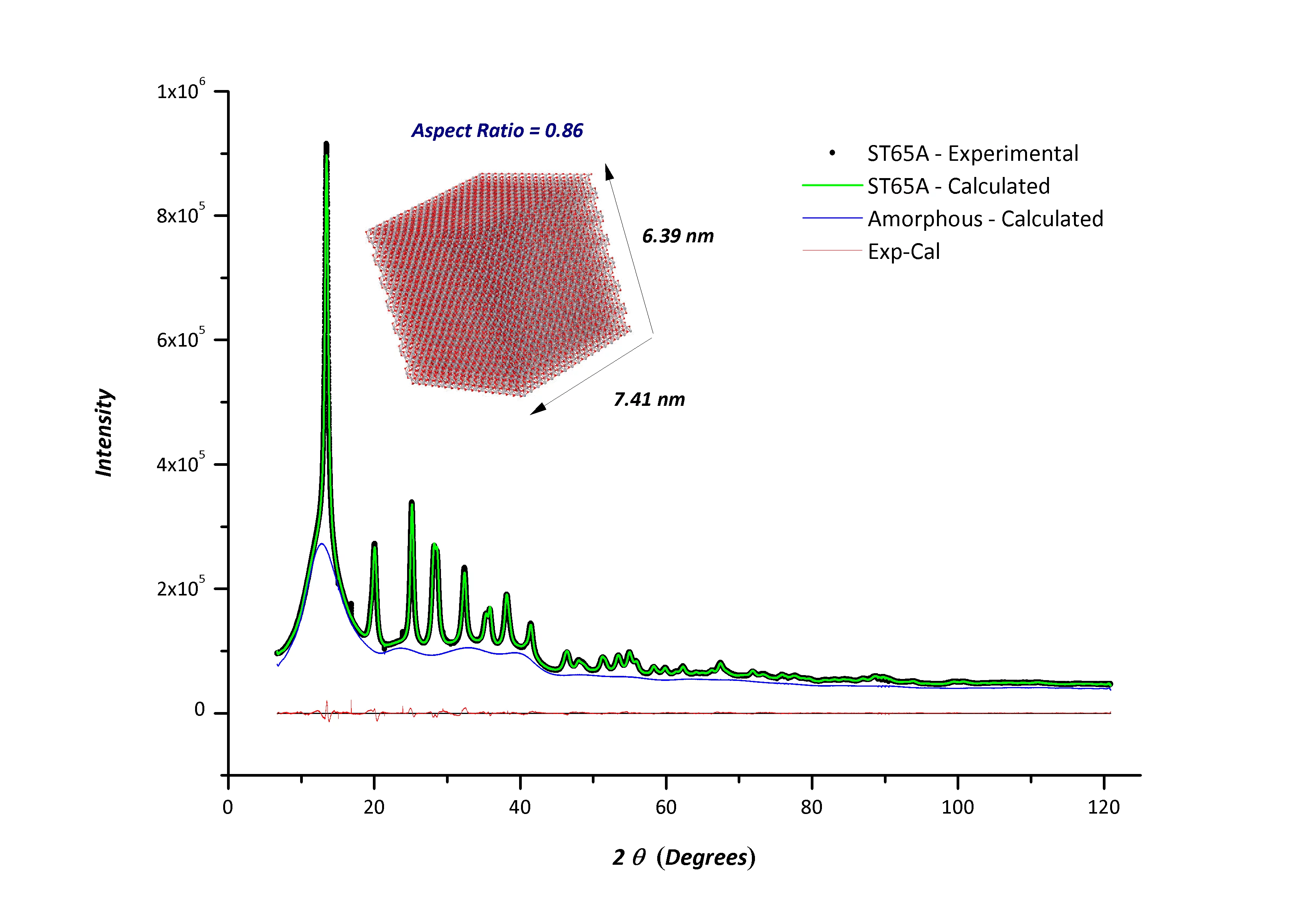IN-HOUSE RESEARCH
Pharmaceutical Applications of SR-XRPD
Ab-initio structural solution and refinement of small organic molecular compounds (e.g. pharmaceuticals) is one of the fields where advanced SR-XRPD instrumentation and new methodologies are perfectly married to each other. Although successful structural solutions from powders have been achieved using laboratory data1, for increased complexity of the system under investigation the outstanding quality of SR-XRPD data is often the key for the success of their structural solution. Small organic molecular compounds, however, are often strongly affected by radiation damage, a normally unavoidable side effect of SR2. Therefore, the combination of SR properties with the very high counting efficiency of the SR detectors, allows collecting data of outstanding quality before irreversible changes in the compound occur. At the SLS-MS powder beamline we have devoted considerable efforts to optimizing the beamline optics, the calibration of the 1-D single-photon counting detector MYTHEN II, the experimental set up and the data collection strategy. Furthermore, the remarkable counting statistics of MYTHEN II even at subsec acquisition times allows us to study in-situ the details of structural transformations.Back to top
X-ray diffraction at High-pressure
In August 2010, the PSI-FoKo (Forschung Kommission, i.e. Research Commission) has approved and financially supported a new research project for the investigation of the crystallographic properties of molecular solids under high-pressure. Specifically, the project aims to:
Back to top
- Develop high-pressure X-ray diffraction techniques at the SLS-MS beamline Powder Diffraction Station
- Combine this with the unique high-resolution and time-resolved capabilities (on the ms scale) developed at the beamline in order to study the kinetic of phase transformations induced by the high pressure on molecular compounds.
- Investigate organometallic materials (including metal-organic frameworks) and pharmaceutical compounds at high pressure, with experimental and theoretical methods.
Back to top
Materials under High Pressure: optical properties
High pressure induces large conformational variations in molecular solids. Material properties depending on molecular conformations are strongly influenced by pressure and can therefore be easily tuned by its application. This is the case for Second Harmonic Generation (SHG) which depends directly on the molecular hyperpolarizability. This in turn is strongly correlated to the molecular conformation, especially for molecules with conjugated donor-acceptor systems. 4-amino-benzophenone, for example, was reported to experience a large increase in its SHG efficiency at high pressure. The study of its structural behaviour in these conditions has permitted the characterization of an iso-symmetric phase transition at around 1 GPa. The enhancement of its SHG response, on the other hand, was shown to be correlated principally with the progressive "flattening" of the molecule.3
Details on this modeling study can be read on a 2006 J. Appl. Cryst. article The Instrumental Resolution Function in the Presence of Focusing Optics
Modelling of Instrumental Resolution Function
A deep understanding of all factors influencing the Instrumental Resolution Function (IRF) of a Synchrotron Radiation X-Ray Diffraction experimental set up is very important because it allows one to minimize the effect of aberrations and/or to choose the best analytical functions for describing the diffraction profile. Furthermore, it allows the modeling and therefore the prediction of the instrumental profile.The Instrumental Resolution Function in the Presence of Focusing Optics
In collaboration with the Institute of Crystallography of the Centro Nazionale Ricerche in Bari, Italy, we have developed a simple analytical approach under the Gaussian approximation to predict IRF behavior for SR powder diffractometers in the presence of focusing optics, using a crystal analyzer detector in +,-,+,-,+,- configuration. The model developed was verified against numerous experiments conducted at the MS-PD station under controlled optics conditions and standard powders.Details on this modeling study can be read on a 2006 J. Appl. Cryst. article The Instrumental Resolution Function in the Presence of Focusing Optics
Instrumental profile of MYTHEN detector in Debye-Scherrer
More recently, in collaboration with Matteo Leoni and Paolo Scardi of the University of Trento, we have conducted a study of the diffraction profile using MYTHEN II data. Several analytical corrections to the main aberrations have been proposed and implemented in two of the most advanced software based on the Rietveld and Whole Powder Pattern Modelling methods, for structure and microstructure analysis, TOPAS and WPPM software, respectively.
Figure 3 shows as an example how the refinement of the Silicon standard powder (NIST 640c) dramatically improved when a correction to sample displacement is applied.
Details on the modeling of MYTHEN II data can be found in our recent Instrumental profile of MYTHEN detector in Debye-Scherrer publication on Z. Kristallographie.
Back to top
The program suite Debussy for using the DFA method is being developed at SLS by Antonio Cervellino, within a collaboration with Dr. A. Guagliardi (Dip.to di Scienze Chimiche ed Ambientali, Insubria University, 22100 Como, Italy and Istituto di Cristallografia, CNR, 70126 Bari, Italy). It is a suite of programs dedicated to refining powder patterns using the DFA, and it is freely available under GPL license (download binaries for Mac OSX and Linux, source code in f95). Debussy - as decribed in Ref. 5 - is especially valuable for extracting information relevant to mixtures of nanocrystals containing different phases and where each phase may have a complex size/shape distribution. It can also refine some global parameters (e.g. phase fractions, background), some parameters for each phase (size/shape distribution parameters) and also parameters that depend on the phase and have also a dependence on the size/shape of the individual crystallite (site occupancy, thermal vibration amplitude, lattice expansion).
Back to top
Details on the modeling of MYTHEN II data can be found in our recent Instrumental profile of MYTHEN detector in Debye-Scherrer publication on Z. Kristallographie.
Back to top
Total scattering: the Debye Function Analysis method for applications to nanomaterials
The novel DFA (Debye Function Analysis) method is a new member of Total Scattering methods for powder diffraction data analysis. For a short explaination of how PDF and DFA work, see the attached PDF vs. DFA. Total Scattering considers the whole diffraction pattern as a source of information and can be used for crystalline as well as non-crystalline structures. The DFA (Debye Function Analysis) method is easy from the experimental point of view, meaning that you need to collect a very high-quality pattern, but you do not need a very large transferred momentum range (just enough that the main scattering features are included in the experimental range), and it works well with impure, polyphasic, polydisperse samples. On the down side it is somewhat computationally intensive. It relies on some modelling of the atomic structure - via the evaluation and transform of the interatomic distances - in order to try to match the experimental data. Background subtraction or reduction is desirable, although the pattern matching algorithm can include some heuristic background function (usually Chebyshev polynomials of small-medium degree) to take into account some weakly varying background.The program suite Debussy for using the DFA method is being developed at SLS by Antonio Cervellino, within a collaboration with Dr. A. Guagliardi (Dip.to di Scienze Chimiche ed Ambientali, Insubria University, 22100 Como, Italy and Istituto di Cristallografia, CNR, 70126 Bari, Italy). It is a suite of programs dedicated to refining powder patterns using the DFA, and it is freely available under GPL license (download binaries for Mac OSX and Linux, source code in f95). Debussy - as decribed in Ref. 5 - is especially valuable for extracting information relevant to mixtures of nanocrystals containing different phases and where each phase may have a complex size/shape distribution. It can also refine some global parameters (e.g. phase fractions, background), some parameters for each phase (size/shape distribution parameters) and also parameters that depend on the phase and have also a dependence on the size/shape of the individual crystallite (site occupancy, thermal vibration amplitude, lattice expansion).
Back to top
Photocatalytic activity of TiO2 nanoparticles vs. their bivariate size/shape distribution
This project is a collaboration between Antonio Cervellino and G. Cernuto (Dip.to di Scienze Chimiche ed Ambientali, Insubria University and Stazione Sperimentale della Seta, 22100 Como, Italy), N. Masciocchi (Dip.to di Scienze Chimiche ed Ambientali, Insubria University, 22100 Como, Italy), A. Guagliardi (Dip.to di Scienze Chimiche ed Ambientali, Insubria University, 22100 Como, Italy and Istituto di Cristallografia, CNR, 70126 Bari, Italy) and G.M. Colonna (Stazione Sperimentale della Seta, 22100 Como, Italy), partly supported by Fondazione CARIPLO (project 2009-2446). The goal of this project is to investigating the photocatalytic activity of TiO2 NPs, prepared by sol-gel methods with different routes for application in the smart textiles field in which stains and odors can be removed by exposure to solar light. Details of the synthesis method affects phase composition (anatase vs. brookite), Ti occupancy, size/shape distribution. All those information can be extracted from an XRPD pattern by Total Scattering methods, in particular using DFA Debye Function Analysis [5]) and then correlated with separate data on photocatalytic efficiency [6].
Samples were prepared as powders and inserted in conventional 0.3 mm capillaries. No sample environment was required for RT experiments. Diffraction patterns of several samples were collected at 17.5 keV and at 11.3 keV at the MS-Powder station of the X04SA beamline, using the Mythen II detector, that is able to yield a high-counting level pattern in a matter of minutes, including measurement of absorption, empty capillary and air. The pattern of one of the samples is shown in Fig. 6 (top).
Samples were prepared as powders and inserted in conventional 0.3 mm capillaries. No sample environment was required for RT experiments. Diffraction patterns of several samples were collected at 17.5 keV and at 11.3 keV at the MS-Powder station of the X04SA beamline, using the Mythen II detector, that is able to yield a high-counting level pattern in a matter of minutes, including measurement of absorption, empty capillary and air. The pattern of one of the samples is shown in Fig. 6 (top).
As a result, the phase composition of all samples could be evaluated [6], together with the exact chemical composition of each phase. For the example shown, 22.4% brookite (refined composition Ti0.92O2) and 77.6% anatase (refined as Ti0.96O2). The bivariate size distribution - the number and mass distribution vs. diameter in the (a,b)-plane and vs. height along c - have also been extracted for each phase. The resulting distributions for one of the samples are plotted in Fig. 6 (bottom). The photocatalytic activity (Fig. 7) could be correlated to particle sizes and their distributions in the various samples [6].
In a separate experiment several samples of a composite of amorphous silica and TiO2 NPs with different concentrations and annealing times were studied. Here the interaction of the NPs with the amorphous matrix is also known to play a role influencing the photocatalytic activity. We have been once more able to fit the patterns with bivariate distributions of TiO2 NPs. Also the amorphous matrix in this case undergoes structural changes. The residual background - after subtracting all unwanted contributions - matches well a separately measured silica pattern, albeit with small differences - that could be correlated to interactions with the admixed NPs. The silica background PDF showed in fact additional peaks traceable to Ti incorporation in the matrix at least at the interface. A systematic study of all correlations is in progress.
Back to top
Back to top
USERS HIGHLIGHTS
Microwave assisted heating
Back to topThe polymorphism of chocolate
Back to topSelf-Propagating Exothermic (SPER) Reactions
Back to topINDUSTRIAL APPLICATIONS OF SR-XRPD
Proprietary Access at the SLS-MS for XRPD measurements
For Proprietary access please contact Dr. Nicola CasatiAutomatic sample charger
This MOVIE describes how the automatic sample changer works at the PD station. More than 100 samples can be analysed in a single proprietary shift (8 hours).Back to top
References
1. K. D. M. Harris, Current Opinion in Solid State and Materials Science 6 (2002) 125–130.
2. Niederwanger, V., Gozzo, F. & Griesser, U. (2009). J. Pharm. Sci. 98, 1064–1074. MS paper
3. E. Marelli, N. Casati, F. Gozzo, P. Macchi, P. Simoncic, A. Sironi (2011) CRYSTENGCOMM 13, 6845
4. Holton, J. M. (2009). J. Synchrotron Rad. 16, 133–142.
5. Gozzo, F., Masciocchi, N., Olieric, V., Wang, M., Griesser, U. & Niederwanger, V. (2010). To be published.
6. A. Cervellino, C. Giannini, A. Guagliardi, J. Appl. Crystallogr. 43 (2010) 1543 MS paper pdf
7. G. Cernuto, N. Masciocchi, A. Cervellino, G.M. Colonna, A. Guagliardi, J. Am. Chem. Soc. 133 (2001) 3114-3119 MS paper
N. Casati & A. Cervellino, reviewed on May, 2012

